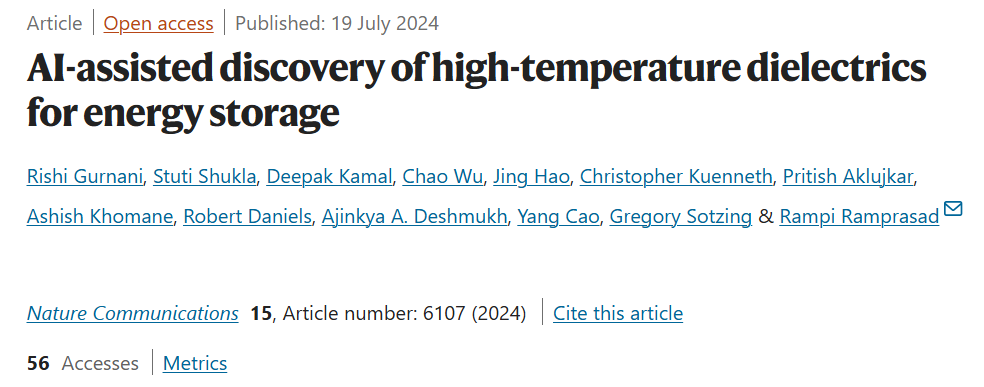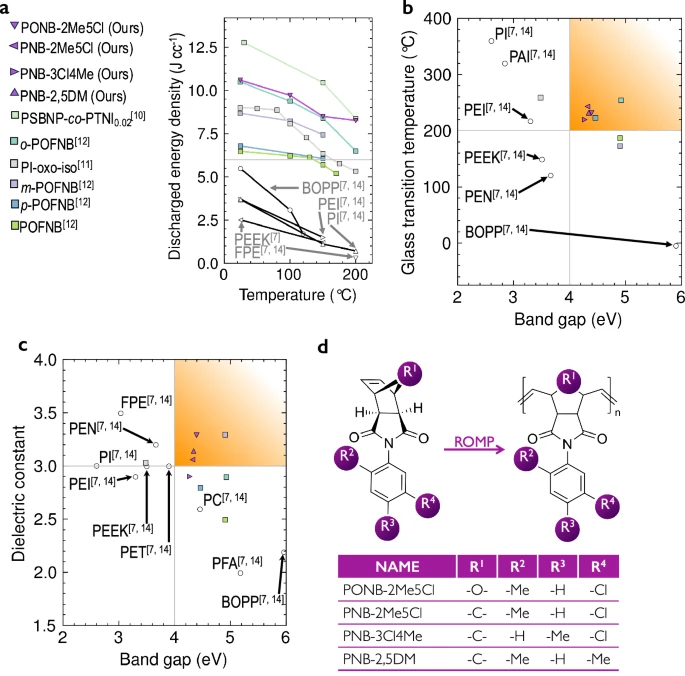Home >Technology peripherals >AI >The performance is 11 times stronger. Georgia Tech and Tsinghua teams used AI to assist in discovering new energy storage materials, published in Nature sub-journal
The performance is 11 times stronger. Georgia Tech and Tsinghua teams used AI to assist in discovering new energy storage materials, published in Nature sub-journal
- WBOYWBOYWBOYWBOYWBOYWBOYWBOYWBOYWBOYWBOYWBOYWBOYWBOriginal
- 2024-07-24 17:42:52482browse

Electrostatic capacitors are key energy storage components in advanced power systems in the fields of defense, aviation, energy and transportation. Energy density is the figure of merit of an electrostatic capacitor and is primarily determined by the choice of dielectric material.
Most industrial-grade polymer dielectric materials are flexible polyolefins or rigid aromatics that have either high energy density or high thermal stability, but not both at the same time.
Here, a research team from the Georgia Institute of Technology, the University of Connecticut, and Tsinghua University used artificial intelligence (AI), polymer chemistry, and molecular engineering to discover polynorbornene and poly A range of dielectrics in the imide family.
Many discovered dielectrics exhibit high thermal stability and high energy density over a wide temperature range. One of the dielectrics has an energy density of 8.3 J/cc at 200 °C, 11 times higher than any commercially available polymer dielectric at this temperature.
The researchers are also evaluating ways to further enhance the polynorbornene and polyimide families so that these capacitors can perform well in demanding applications such as aerospace while being environmentally sustainable.
These findings expand the potential applications of electrostatic capacitors in the 85-200°C temperature range; also demonstrate the impact of artificial intelligence on chemical structure generation and property prediction, highlighting the potential for advancements in materials design beyond electrostatic capacitors.
The research was titled "AI-assisted discovery of high-temperature dielectrics for energy storage" and was published in "Nature Communications" on July 19, 2024.

Electrostatic capacitors play a vital role as energy storage devices in modern electrical systems. Compared with other energy storage devices such as batteries, fuel cells and supercapacitors, electrostatic capacitors provide excellent power density (107 W/kg) and are used in wind pitch control (maximum temperature around 125 °C), hybrid and It has advantages in various fields such as fully electric vehicles (approx. 150 °C), pulsed power systems (approx. 180 °C), aircraft and launchers (approx. 300 °C) and space exploration (approx. 480 °C).
However, it remains a challenge to significantly increase the energy density Ue of electrostatic capacitors at high temperatures, which is crucial to achieve significant savings in space and weight.
Currently, biaxially oriented polypropylene (BOPP) has been used as a dielectric material for more than thirty years. Although BOPP has low dielectric loss and large electronic band gap Eg, its dielectric constant and high temperature stability are poor.
BOPP alternatives with high thermal stability have been explored commercially, but these polymers often come at the expense of low Eg and low Ue. These materials are insufficient to meet the needs of modern and future technologies.
Challenges of Materials Discovery
The performance of polymers depends largely on their chemical composition. The number of variants that can be produced from a single polymer through chemical transformations is staggering.
Among all the chemical possibilities of polymers, there may be many high-performance dielectric materials yet to be discovered. Artificial intelligence (AI) trained and calibrated, capable of processing vast amounts of data beyond human imagination, can quickly help discover new materials.
Efficient material discovery involves selecting or generating a chemical subspace, estimating the properties of each material within it, and then selecting candidate materials for synthesis and testing based at least in part on the estimated properties.
The challenge is to (1) create a subspace broad enough to discover unknown new materials while (2) limiting hypothetical materials that are difficult to synthesize (false positives). Furthermore, property estimates must be (3) accurate and (4) efficient, with the latter becoming increasingly important as chemical subspaces expand.
However, solving all these problems at the same time is not easy.
New paradigm polyVERSE
Researchers from Georgia Institute of Technology, Tsinghua University and other institutions proposed the polyVERSE (polymers designed by Virtually-Executed Rule-Based Synthesis Experiments) paradigm, demonstrating its realization of these four properties in the context of high-temperature dielectric search success.
In an AI-driven approach, an expert system is used to generate polymers from commercially available monomers and a multi-task graph neural network is used to estimate properties. These property estimates can be used to select (screen) promising polymers from larger populations.

1. Innovative polynorbornene dielectric
Researchers discovered a previously unknown polynorbornene dielectric called PONB-2Me5Cl.
2. Excellent energy density
在 200°C 時,PONB-2Me5Cl 具有 8.3 J/cc 的出色能量密度,高於所有商業替代品,使其成為在此溫度下報道的最佳聚合物電介質之一。
3. 與其他聚合物比較
在 200°C 以下,PONB-2Me5Cl 的能量密度也高於所有商業聚合物,僅次於 PSBNP-co-PTNI0.02。
4. 合成考量
由於 PSBNP-co-PTNI0.02 是一種共聚物,其合成可能需要更多步驟。此外,測量協議的差異也可能影響比較結果。

PONB-2Me5Cl 是使用 polyVERSE 演算法 在電腦中發現的,隨後進行了合成和表徵。 高性能 PONB-2Me5Cl 聚合物的發現 和 polyVERSE 範式的開發 是這項工作的兩個成果。
此外,團隊提出了一系列未來需要考慮的聚合物設計最佳化。這些包括:
- PONB-2Me5Cl 的改良版本 (透過R 基團工程或加入奈米填料或塗層實現)
- 精選聚酰亞胺,這是研究人員根據現有的功能性
,這是研究人員根據現有的功能性
精選聚酰亞胺,這是研究人員根據現有的功能性高溫聚合物優先考慮的一類。
這些設計顯示出提高高溫 Ue 和減少損失的潛力,同時也允許使用綠色溶劑進行合成。 僅使用眾多聚合模板中的一種,這項研究就展示了
人工智慧🎜 在生產具有出色能量儲存能力的先進聚合物電介質方面的強大功能。 🎜🎜🎜論文連結:🎜 https://www.nature.com/articles/s41467-024-50413-x🎜The above is the detailed content of The performance is 11 times stronger. Georgia Tech and Tsinghua teams used AI to assist in discovering new energy storage materials, published in Nature sub-journal. For more information, please follow other related articles on the PHP Chinese website!
Related articles
See more- Technology trends to watch in 2023
- How Artificial Intelligence is Bringing New Everyday Work to Data Center Teams
- Can artificial intelligence or automation solve the problem of low energy efficiency in buildings?
- OpenAI co-founder interviewed by Huang Renxun: GPT-4's reasoning capabilities have not yet reached expectations
- Microsoft's Bing surpasses Google in search traffic thanks to OpenAI technology

